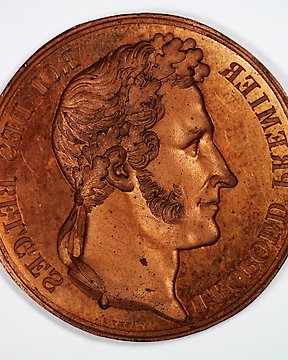
Belgien. Leopold I (1831-1865). Historical Medal Galvanoplactic medal set after: Services rendus pendant l''épidémie de choléra. By: Braemt. Scare! (Ohne Mindestpreis)
Nr. 87458031

Nr. 87458031

Galvanoplactic medal set after: 20th birthday Duke of Brabant (Leopold II) by: Wiener. 1845.
Leopold II was born on April 9, 1835, in Brussels, Belgium, as the second son of King Leopold I and Queen Louise-Marie of Orléans. From a young age, he was prepared for a future role in governance, receiving a strict and formal education focused on military and diplomatic affairs. Growing up in the Belgian royal court, Leopold was instilled with a strong sense of duty and ambition.
He traveled extensively across Europe during his youth, gaining exposure to different cultures and political systems, which shaped his views on colonialism and governance. In 1853, at the age of 18, Leopold married Archduchess Marie Henriette of Austria, a union that was largely arranged for political reasons. As the heir to the throne after the death of his older brother, Leopold increasingly involved himself in national and international matters, preparing for his future role as king. His early experiences laid the foundation for his later ambitions, particularly his interest in expanding Belgium's influence through colonial ventures. Leopold became King of Belgium in 1865.
Galvanoplactic medal set after the Medal, BELGIUM, Kingdom, AE medal, undated (1832), Braemt. Propagation of the vaccine. Obverse: Bare head of Leopold I to the left. Reverse: Dairy cow standing to the right. In the field, a lancet. Guioth, Belgian Revue, 156; Turner 260. Scare.
See photo's for your own impression.
In the context of medals and coins, galvanoplastic refers to a method of reproduction or replication using electroplating techniques.
Galvanoplastic reproduction involves creating a mold, typically made of wax or another suitable material, which is then coated with a conductive layer, such as graphite or metallic powder. This conductive layer allows the mold to conduct electricity.
Next, the mold is submerged in an electrolytic bath containing a solution of metal ions, such as gold, silver, or copper. When an electric current is passed through the bath, metal ions are deposited onto the conductive mold, gradually forming a layer of metal that replicates the original design.Once the desired thickness of metal has been deposited, the replica is carefully removed from the mold. The result is a faithful reproduction of the original design, with intricate details faithfully replicated in the final metal product.
Galvanoplastic reproduction is commonly used in the production of medals, coins, and other objects where precise replication of intricate designs is required.
Galvanoplastic reproduction is frequently performed by artists, designers, museums, and researchers. It allows them to create faithful replicas of original artworks, medals, coins, and other objects with intricate designs. This technique is particularly useful for preserving and disseminating cultural heritage, as it enables the production of multiple copies while safeguarding the integrity of the original piece.
In addition to the replication process, it's common to find an old catalog number on the reverse side of galvanoplastic reproductions. This number serves as a reference point for cataloging and identifying the reproduction within a collection or archive. It helps maintain accurate records and facilitates research and documentation of the reproduced objects
So kaufen Sie auf Catawiki
1. Etwas Besonderes entdecken
2. Höchstgebot abgeben
3. Sichere Zahlung durchführen